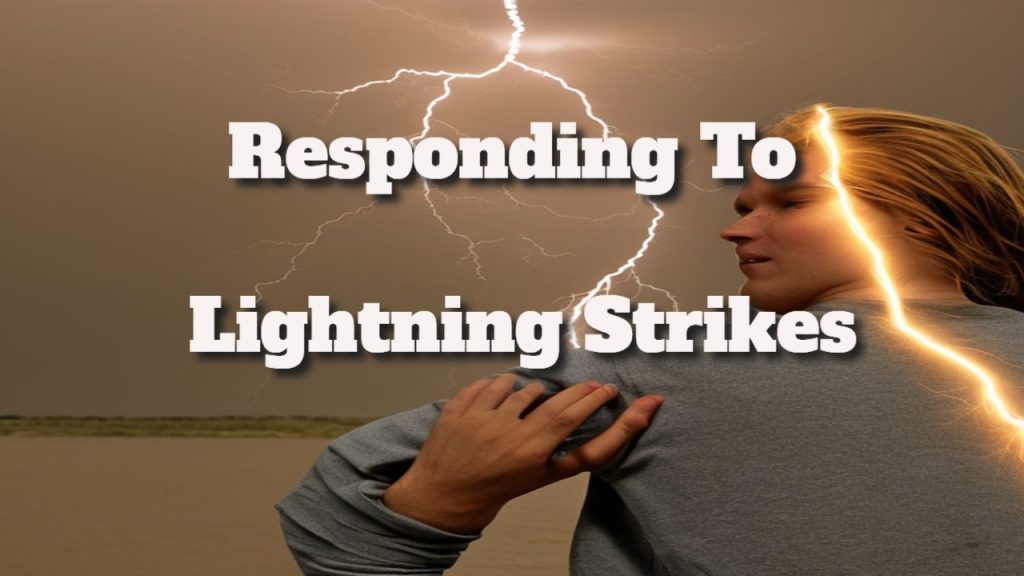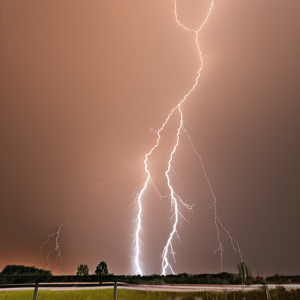Master Lightning Safety: Proven Techniques to Protect Yourself from Strikes
Exploring the Intricacies of Lightning: Risks and Natural Phenomena Explained
Lightning is not only a stunning natural phenomenon, but it also embodies a formidable force of nature that can be both mesmerizing and perilous. Understanding the science behind lightning is crucial for recognizing the associated hazards that can arise, particularly during severe weather conditions. By delving into the complexities of this electrifying occurrence, we can lay the groundwork for effective safety strategies that will be elaborated upon in the following discussions.
Essentially, lightning represents a rapid electrical discharge that occurs during thunderstorms, which is a consequence of the accumulation and subsequent release of static electricity in the atmosphere.
Inside thunderclouds, interactions between ice particles and water droplets cause a separation of electric charges: positively charged particles ascend to the cloud’s upper regions, while negatively charged particles congregate at the bottom. This charge imbalance establishes the necessary conditions for the awe-inspiring yet potentially dangerous lightning storms.
Lightning appears in various forms, each exhibiting distinct characteristics. The most common type is referred to as cloud-to-ground lightning, which originates from the base of a thundercloud and strikes the earth directly.
This type of lightning is infamous for its devastating power, striking with remarkable speed and destructive intensity. Another variation, known as cloud-to-cloud lightning, occurs between different regions within the same storm cloud.
Cloud-to-cloud lightning often produces breathtaking flashes that brighten the night sky, creating a captivating visual display that enchants those who witness it.
While the stunning spectacle of lightning can be awe-inspiring, it is imperative to remain cognizant of the significant dangers that accompany it.
Lightning strikes can result in severe injuries or even fatalities, with thousands of lives lost annually due to this natural threat. Awareness is key to effectively mitigating these risks.
It is crucial to understand that lightning can strike even when a storm appears distant, as the electrical charge can traverse considerable distances. Recognizing the dangers associated with lightning is vital for enhancing our safety measures.
Armed with this knowledge, we can better appreciate the urgent necessity for proactive safety protocols. By deepening our understanding of the complexities surrounding lightning, we can equip ourselves with efficient strategies to mitigate the associated risks.
To gain further insight into the generation of lightning, it is essential to investigate the various elements that contribute to its formation. Thunderstorms serve as the primary catalysts for lightning, providing the crucial ingredients of moisture, unstable air, and updrafts.
When these factors converge, they create the ideal conditions for spectacular electrical discharges. Thunderstorms typically arise in warm, humid environments where rising warm air interacts with cooler air masses.
The clash between these contrasting air masses produces the necessary conditions for thundercloud formation, which is vital for lightning generation.
The dynamics of air movement within a thundercloud are critical. Updrafts collide, facilitating the interaction of tiny ice particles and water droplets, leading to charge separation. This process sets in motion the intricate sequence of events that culminates in lightning.
As positive and negative charges accumulate, a powerful electric field develops within the cloud. Eventually, when this electric field reaches a threshold intensity, a discharge occurs, resulting in a lightning strike.
The ability of lightning to illuminate the intricate dynamics of our environment is truly astonishing. The various hues of lightning can indicate the composition of storm clouds.
For example, blue or purple lightning suggests the presence of ice particles, while yellow or red lightning may indicate dust or pollution within the cloud. By examining these characteristics, scientists can glean valuable insights into the meteorological conditions that foster lightning formation.
Despite the breathtaking beauty of lightning captivating many, it is essential to remain vigilant regarding the inherent hazards associated with this powerful natural phenomenon. Lightning strikes occur at astonishing speeds, and their destructive capacity should never be underestimated.
In the upcoming sections, we will delve into various safety strategies that are crucial for our protection in the event of a lightning strike.
By equipping ourselves with knowledge and implementing preventive measures, we can significantly reduce the risks and protect ourselves from lightning strikes. Let’s embark on this enlightening journey together to uncover the secrets of lightning strike safety.
Proven Safety Measures to Protect Against Lightning Strikes
When lightning strikes, it presents a universal threat, as this formidable natural phenomenon can occur suddenly and without notice.
Establishing effective safety protocols and protective measures is critical for ensuring your safety during a lightning event. By taking these actions, we can substantially reduce the risk of being struck while safeguarding ourselves and those around us.
The foremost precaution during an approaching thunderstorm is to remain indoors. This action offers the highest level of protection against potential lightning strikes. Ensure you seek shelter in a robust building, particularly one equipped with a lightning protection system.
Avoid seeking refuge in open garages, picnic shelters, or any other structures that lack adequate protection. While indoors during a thunderstorm, maintain a safe distance from windows, doors, and electrical devices.
If finding indoor shelter is not feasible, look for appropriate temporary refuge. Steer clear of isolated trees, wide-open fields, or large metal structures, as these can act as lightning rods.
To minimize the risk of a direct strike, locate a low-lying area away from potential lightning rods, and lie flat with your hands covering your ears.
It is also vital to be aware of lightning safety protocols in various outdoor activities. Always check weather forecasts before engaging in outdoor activities such as hiking, golfing, or swimming.
By seeking shelter or avoiding outdoor activities during thunderstorms, you can significantly decrease your risk of being struck by lightning.
Remember, minimizing your chances of being struck by lightning is crucial for your safety. By staying indoors, seeking proper shelter, and understanding lightning safety recommendations, we can effectively protect ourselves and those around us.
Nevertheless, safety measures extend beyond these basic actions. By taking proactive steps, individuals can further lessen their risk of lightning strikes and ensure their safety during thunderstorms.
Avoiding contact with water during rainstorms is a critical safety measure. Being in or near water increases the risk of lightning strikes, as water is an excellent conductor of electricity.
If you’re participating in activities such as swimming or boating, exit the water immediately upon hearing thunder or witnessing lightning. Remain indoors or inside a fully enclosed vehicle until the storm has passed.
Additionally, understanding the “30-30 rule” is vital for safety during thunderstorms.
If there are fewer than 30 seconds between seeing lightning and hearing thunder, seek cover immediately. It is also advisable to remain safe indoors for at least 30 minutes after the last flash of lightning or rumble of thunder.
Creating an action plan for outdoor sports and recreational activities is essential. Coaches, organizers, and participants should establish clear guidelines for lightning safety.
In anticipation of forecasted thunderstorms, it is imperative to suspend all activities and relocate everyone to a designated safe location.
To mitigate unnecessary risks, outdoor sporting events, such as golf tournaments or football games, may need to be postponed or rescheduled.
Educating children, youth, and adults about lightning safety at home and in schools is also a vital aspect of safety planning.
By raising awareness of lightning dangers and safety practices, individuals can make informed choices to safeguard themselves during thunderstorms.
A comprehensive approach that combines practical safety measures, precautions, and advanced strategies is essential for ensuring safety during thunderstorm events.
By avoiding water during thunderstorms, understanding the 30-30 rule, developing action plans for outdoor activities, and promoting awareness of lightning safety, we can significantly lower the likelihood of lightning strikes.
Stay vigilant and informed, as your safety and the safety of those around you should always be a top priority.
Key Response Actions for Lightning Strike Emergencies
Lightning strikes can occur suddenly and pose a serious threat to our lives. Understanding the correct protocols, including essential first aid techniques, calling for help, and assisting injured individuals, is crucial in these critical situations.
First and foremost, personal safety must be prioritized in the event of a lightning strike. If you find yourself outdoors during a thunderstorm, seek cover immediately.
Avoid wide-open spaces, tall isolated structures, and any bodies of water, as these can act as conductors for lightning. Instead, seek refuge in a sturdy building or a fully enclosed vehicle with closed windows. Refrain from sheltering under trees or in temporary structures, as these offer minimal protection.
Once you have secured appropriate shelter, adhere to safety guidelines. Remember that electrical appliances, plumbing fixtures, and telephones can conduct electricity.
Avoid showering or bathing during a thunderstorm, as water is a highly efficient conductor of electricity. Stay away from windows, doors, and concrete walls, which lightning can penetrate.
If someone is struck by lightning, swift action is critical. Assess the individual’s breathing and pulse. If either is absent, call 911 and initiate cardiopulmonary resuscitation (CPR) if you are trained.
Initiating resuscitation as soon as possible can significantly elevate the chances of survival. If the victim is conscious but injured, provide assistance until medical help arrives.
In the event of a lightning strike, every second counts. Stay calm, act swiftly, and ensure the safety of everyone involved by following the necessary procedures. By understanding these protocols, we can protect ourselves and those around us from the dangers of lightning strikes.
With this knowledge, we can be better prepared for emergencies that may arise from lightning strikes. We will delve into advanced first aid procedures relevant to these situations and emphasize the importance of being informed and connected.
Be prepared for the unexpected, as emergencies can occur in an instant. Knowledge and readiness are paramount to safeguarding ourselves and others during lightning strikes.
By familiarizing ourselves with advanced first aid techniques and staying educated on critical response measures, we enhance our ability to respond effectively to lightning strike incidents.
Exercise caution when administering first aid to anyone struck by lightning. Remember that even if there are no visible signs, lightning can cause severe burns and internal injuries.
Start by assessing the individual’s airway, breathing, and circulation. If the person is unresponsive or lacks a pulse, call 911 immediately and begin CPR if you are trained.
Initiating resuscitation promptly can dramatically enhance survival rates.
While waiting for medical assistance, focus on anyone who is unconscious but injured. Always keep in mind the four primary goals in these critical situations:
- Stabilize the individual.
- Maintain appropriate body temperature.
- Minimize the risk of further injuries.
- Ensure the individual receives medical care as soon as possible.
If the person is experiencing difficulty breathing, has burns, or exhibits chest pain, immediate medical attention is crucial.
Discussing the importance of being informed and connected during lightning events is vital. Weather conditions can shift rapidly, making it essential to stay updated about impending severe weather to take preventative actions.
Stay informed about severe weather alerts by regularly checking forecasts, listening to local news, or utilizing weather apps. Maintain communication with family, friends, or colleagues to ensure everyone is aware of safety protocols and can assist if needed.
Understanding advanced first aid techniques and remaining current on lightning safety enables us to respond effectively and protect those at risk.
Remember, while lightning strikes are unpredictable, we can safeguard ourselves by arming ourselves with knowledge and remaining vigilant. Stay safe, informed, and prepared for the unexpected.
The Article Lightning Strike Protection: Stay Safe During Storms Appeared First On Survival Avenue.
The post Lightning Strike Protection Tips for Storm Safety appeared first on Survival Bite.
The Article Lightning Strike Protection: Essential Tips for Safety During Storms Was Found On https://limitsofstrategy.com




It’s interesting how lightning can be both beautiful and terrifying at the same time. I remember being a kid, staring out the window during a storm, fascinated by the flashes. But now, knowing more about the dangers—especially after hearing about a friend’s experience during a camping trip gone wrong—I’ve gained a whole new respect for it.
It’s fascinating how our perceptions of nature can shift as we grow older. As kids, we often see things through a lens of wonder, where the beauty of a lightning flash is enough to hold our attention completely. I remember those moments too, when the sky would light up and the thunder would rumble like Mother Nature’s applause. It’s one of those experiences that feels almost magical, like a performance we’re lucky to witness.
Your exploration of lightning, both as a natural phenomenon and a serious safety concern, really resonates with me. Growing up in a region that frequently experiences thunderstorms, I became acutely aware of the risks involved. There were moments when the power of nature felt both awe-inspiring and terrifying, especially during those intense summer storms.
It’s interesting how nature can evoke such a mix of emotions, isn’t it? Those summer thunderstorms can really take your breath away with their power, but they definitely remind us of our vulnerability too. I grew up in a place where thunderstorms rolled in unexpectedly, and I still remember the anticipation that would build when the sky darkened and the first crack of thunder echoed. It was like a reminder of nature’s might, but also a prompt to seek shelter.
It’s interesting how our experiences shape our understanding of natural phenomena like lightning. Growing up in a region where thunderstorms are a regular occurrence can definitely give someone a unique perspective on the balance between nature’s grandeur and its potential hazards. The feelings of awe and fear you described resonate deeply with many people who have found themselves caught in the midst of a storm.
“I’m glad to hear you relate to those intense summer storms; they truly highlight nature’s dual power. If you’re interested in learning more about lightning safety and preparedness, check out this resource!”
https://cnisclub.org/octopus